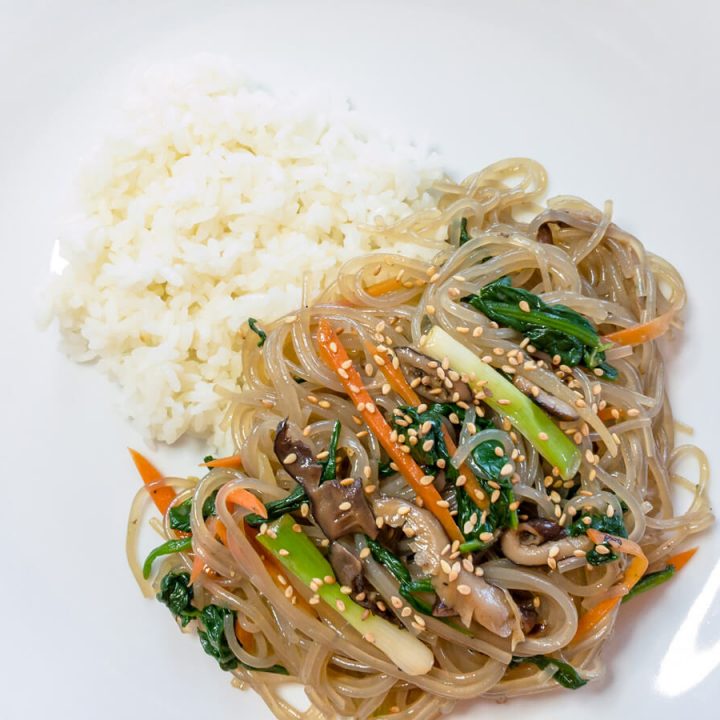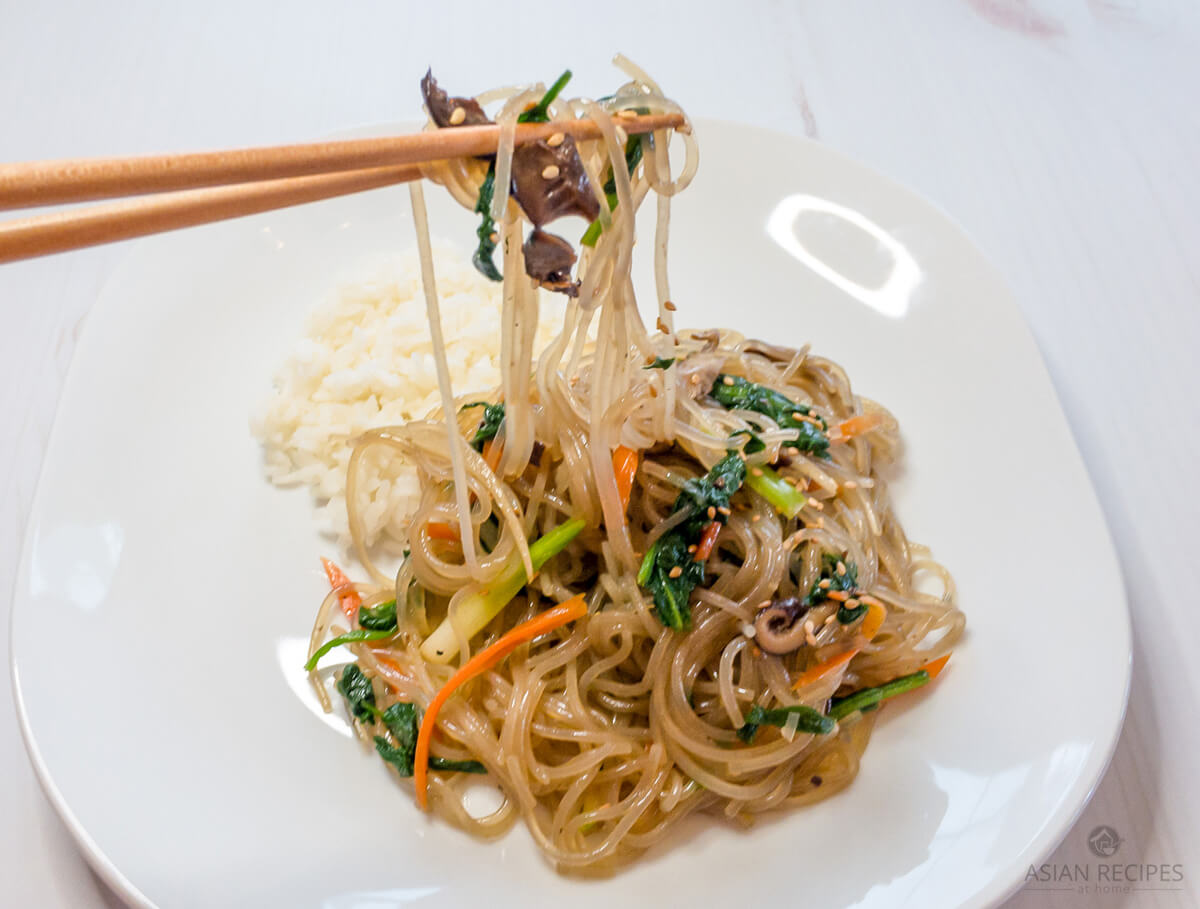Japchae (or chapchae) is a popular Korean dish made with sweet potato starch noodles. Learn how to make delicious japchae filled with vegetables with our tried-and-true recipe!
Our vegetable japchae recipe
Typically, the chewy and springy Korean glass noodles are combined with thin slices of beef (or pork) and other veggies in a slightly sweet and salty sauce for a traditional japchae. However, in this recipe, we omit the meat and bulk up on the vegetables. Feel free to add meat if you’d like, or even add pan-fried tofu for a meat substitute. Although, we love this japchae as-is with all of the vegetables.
What is japchae
The Korean dish japchae, or chapchae, is one of the most popular dishes. It is the most popular meal in Korea, especially during the Korean festive holidays (such as New Year’s Day and Harvest Festival), but it is also appreciated on any other regular day.
Japchae was a noodle-free dish when it was initially invented in the 17th century. Today, however, the potato starch noodles (dangmyeon, 당면), also known as glass noodles, are the main feature of the recipe.
Japchae should have a sweet and savory flavor balance, crisp vegetable texture (not too raw or soft), and bouncy noodle texture (not mushy).
What does japchae mean in Korean?
Japchae, which means “combination of vegetables,” refers to both the food and the method of preparation. In general, the name refers to stir-fried veggies (namul) with meat.
Ingredients needed for this vegetable japchae
- Korean sweet potato starch noodles
- Carrots
- Green onions
- Dried shiitake mushrooms
- Yellow onion
- Avocado oil
- Water
- Sesame oil
For the spinach:
- Fresh spinach
- Soy sauce
- Salt
- Sesame oil
- Sugar
- Garlic
- Ground black pepper
- Mushroom umami powder
For the japchae sauce:
- Soy sauce
- Seasoning sauce
- Mushroom umami powder
- Salt
- Ground black pepper
- Sugar
- Garlic
- Fish sauce** or See Notes
Is japchae served hot or cold?
Japchae is a popular Korean dish that can be served hot or cold. You can also reheat it in the microwave if necessary. Serve it as an appetizer, a side dish, or a main meal over a bed of rice.
How to store leftovers
Keep any leftover japchae refrigerated in an airtight container. It can keep for 3 to 4 days in the fridge and reheats well in the microwave. When the noodles are reheated, they become soft and chewy again.
Tips for making our japchae recipe
- Read the instructions all the way through first. That way you are familiar with the overall process before starting.
- We stir-fry each vegetable separately as they each have different optimum cooking times. I understand, it seems unnecessary to some! However, by cooking them individually, you can better bring out their distinct flavors, textures, and colors. Trust us, this really separates decent japchae from great japchae.
- We love using dried shiitake mushrooms. They are easy to store and seemingly last forever if stored correctly. Make sure you plan ahead to rehydrate the shiitake mushrooms.
- Cut the noodles to about a 6-inch length after they are cooked. This makes it much easier to eat and also when stirring everything together at the end.
More noodle recipes to try
- Instant Chapagetti Jajang Noodles
- Easy Gochujang Noodles
- Easy Asian Stir-Fried Rice Noodles with Shrimp
- Korean Cold Noodles in a Spicy Kimchi Sauce
- Korean Cold Buckwheat Noodles in a Chilled Broth
HUNGRY FOR MORE? Subscribe to our newsletter and follow along on Facebook, Pinterest, Twitter, and Instagram for all of the latest updates.

Vegetable Japchae (Korean Glass Noodle Stir-fry)
Japchae (or chapchae) is a popular Korean dish made with sweet potato starch noodles. Learn how to make delicious japchae filled with vegetables with our tried-and-true recipe!
Ingredients
- 1 lb Korean sweet potato starch noodles
- 1 cup carrots, julienned
- 4 Green onions, chopped 2” length pieces
- 6 medium-sized dried shiitake mushrooms, rehydrated in warm water (see step 1)
- 1 cup yellow onion, thinly sliced
- 2 Tablespoons of avocado oil
- 10 cups water
- 3 Tablespoons sesame oil
For the spinach:
- 1lb fresh spinach, (1 cup after blanched)
- 1 teaspoon soy sauce
- ¼ teaspoon salt
- 1 Tablespoon sesame oil
- ¼ teaspoon sugar
- ½ teaspoon garlic, minced
- ¼ teaspoon ground black pepper
- ½ teaspoon mushroom umami powder
For the japchae sauce:
- 3 Tablespoons soy sauce
- 1 Tablespoon seasoning sauce
- 2 teaspoons mushroom umami powder
- ½ teaspoon salt
- ¼ teaspoon ground black pepper
- 1 Tablespoon sugar
- 2 teaspoons garlic, minced
- 2 teaspoons fish sauce**
Instructions
- Make sure to rehydrate the shiitake mushrooms according to package instructions or in warm water for about 6 hours. Rinse and squeeze as much water out of the mushrooms. Remove stems (but save them see Notes below*) and slice thinly.
- We need to stir-fry each vegetable separately. Add a splash of avocado oil to coat the bottom of the pan to stir-fry each vegetable separately. Cook the carrots for about 3-4 minutes. Set aside on a large plate. Add another splash of avocado oil to the same pan and cook the onions for about 8-9 minutes. Set aside on a large plate with the carrots. Add another splash of avocado oil to the same pan and cook the green onions for about 2-3 minutes. Set aside on the same plate as the carrots and onions.
- Place a large pot half-filled with water on high heat. Bring the water to a boil. Blanch the spinach for 1 minute. Drain and rinse with cold water. Squeeze as much water from the spinach out as possible. Slice the spinach so that it’s in about 1-inch pieces. Place the spinach in a bowl, add in all of the seasonings for the spinach, and massage into the spinach well. Set aside.
- You can use the same large pot you used for the spinach in the previous step and half-fill it with water. Bring the water to a boil. Once the water is boiling, add in the japchae noodles. Cook for about 8-10 minutes and stir intermittently. Noodles are done when the middle of the noodle is no longer hard. (You can also cook according to package instructions.)
- Once noodles are done, strain the noodles and rinse with cold water to stop the cooking.
With a pair of kitchen shears, cut the cooked noodles so they’re about 6” in length.
At the bottom of a large pan or use the same pot you just boiled the noodles in, add in the 3 Tablespoons of sesame oil, and turn it on to low heat. - Add the noodles, stir-fried vegetables, shiitake mushrooms (except spinach), and the japchae sauce. We usually put food-safe gloves on and mix everything together with our hands on the low heat for about 5 minutes for this step. If you don't want to use your hands, then use a wooden spoon to slowly mix everything together well.
- Finally, add the seasoned spinach, and mix it in well for 2-3 minutes.
- Enjoy!
Notes
*You can keep the shiitake mushroom stems to put in any soup or stew. Don’t throw out the stems!
**You can substitute for 2 more teaspoons of mushroom umami powder if you want it vegan/vegetarian friendly.
We love seeing your creations from our recipes! Tag us on Instagram at @AsianRecipesAtHome.
Disclaimer: Under no circumstances shall this website and the author(s) be responsible for any loss or damages resulting from the reliance of the given nutritional information or ingredient/product recommendations. Recommended ingredients/products can change their formula at any time without this website and author’s awareness. It is your responsibility (the reader’s) to check the label/ingredients of any product prior to purchasing and/or using. We greatly appreciate your support and understanding.



